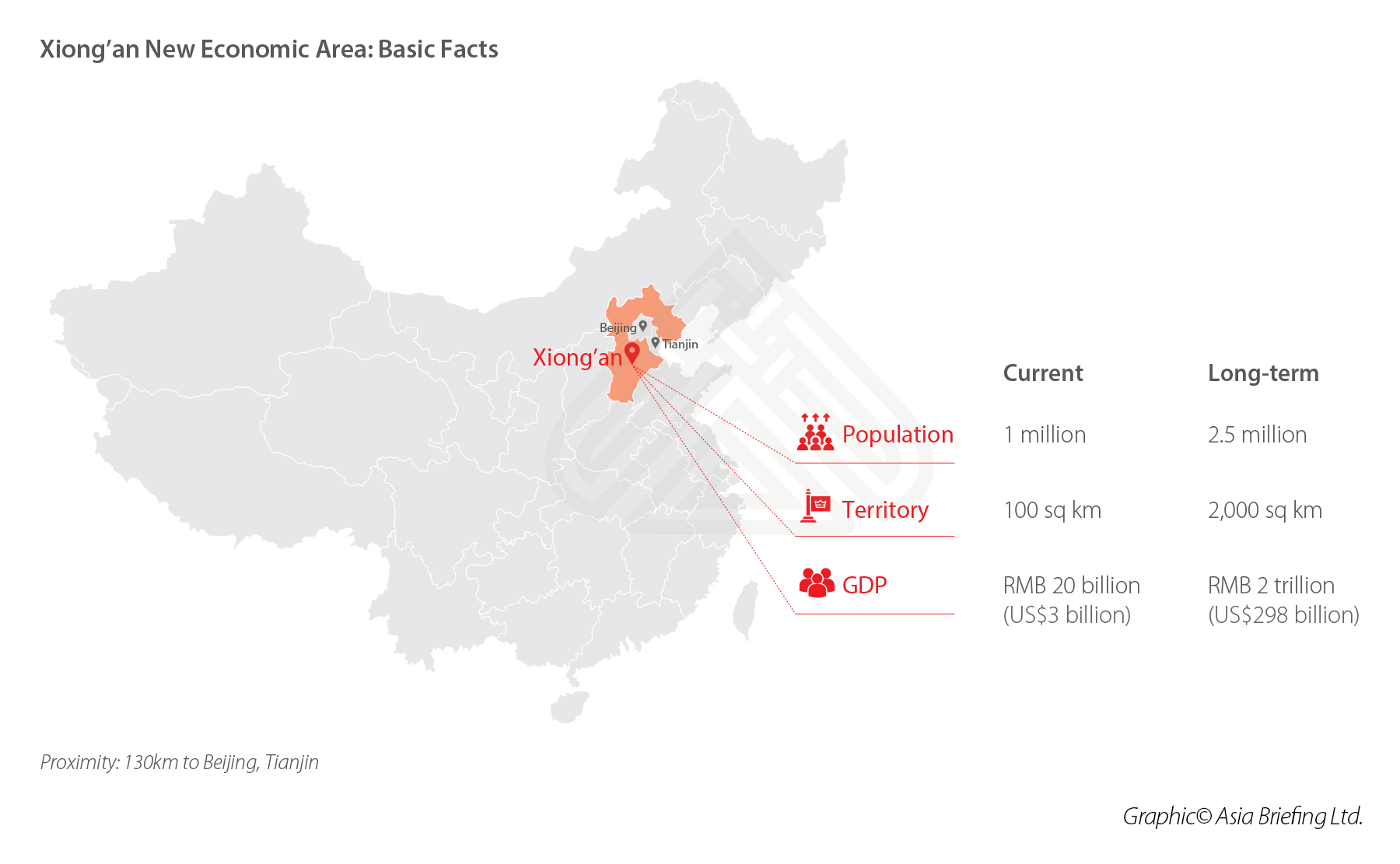Xiong’an New Area: President Xi’s Dream City

The Xiong’an New Area aims to facilitate the integration of Beijing, Tianjin, and Hebei. China Briefing assesses the program to develop this new city and its socioeconomic profile.
On April 1, 2017, President Xi Jinping announced a plan to transform Xiong’an in China’s Hebei province into a green and innovative city. The Xiong’an New Area will be China’s 19th national-level new district and new economic zone.
Analysts estimate that RMB 4 trillion (US$580 billion) could be spent on building Xiong’an over the next two decades as the New Area is still a rural territory. Chinese media has heralded Xiong’an’s development program as “a millennium strategy”, which could see it become the next Shenzhen and Pudong, China’s main business centers.
In this article, we look at the key functions that will get transferred to Xiong’an and industries that are promoted in the area; we also assess the concerns regarding the project’s top-down approach.
Xiong’an will facilitate Beijing-Tianjin-Hebei integration
Xiong’an’s key function is to facilitate the Beijing-Tianjin-Hebei (BTH) integration. The New Area is in Hebei province in North China, approximately 130 km southwest of Beijing.
Hebei provincial authorities will spend RMB 600 billion (US$91 billion) on building its transport infrastructure by 2020.
Four high-speed train lines will run through Xiong’an while two canals will connect the New Area to Beijing and Tianjin.
By high-speed railway, it will take only 20 minutes to travel from Xiong’an to Beijing’s planned new airport in Daxing District, 30 minutes to Beijing and Tianjin, and an hour to Shijiazhuang, the capital of Hebei province.
Relocation of Beijing’s non-capital functions
Additionally, it has been planned that non-capital functions in Beijing will be transferred to Xiong’an. Some of Beijing’s colleges, hospitals, business headquarters, public services, and financial institutions will be relocated to the New Area. For instance, Peking University’s Guanghua School of Management and Renmin University of China will establish a training center and medical college, respectively, in Xiong’an.
The China Shipbuilding Industry Corporation, the largest shipbuilding conglomerate in the country, will also move its headquarters from Beijing to Xiong’an.
Xiong’an is expected to become an attractive city for talented migrants. Zhongguancun, a technology hub in Beijing that is considered equivalent to China’s Silicon Valley, will construct a science park in the New Area. It aims to attract 12 energy conservation and environmental protection companies, as well as around 500,000 scientists from Beijing.
Hub for cutting-edge technology industries
According to the government official, 80 percent of the Xiong’an New Area’s economic growth will come from cutting-edge technology industries. Xiong’an will give priority to investments in high-tech industries, including information technology, biotechnology, and new materials.
China’s top technology giants – Baidu, Alibaba, and Tencent – will establish their branches in Xiong’an. Major Chinese telecommunication companies, including China mobile, Unicom, and Telecom, will test their 5G wireless networks in the New Area.
The New Area will step up the construction of intelligent infrastructure, a smart mode of city administration, and a management system for data assets.
In December 2017, Baidu tested its self-driving cars in Xiong’an where the traffic could be regulated by artificial intelligence. Ideally, these technological breakthroughs will prevent traffic jams in the city.
In February 2018, China signed a deal with the United Kingdom worth US$11.4 billion to build a joint financial technology center at Xiong’an.
A green urban space
According to the State Council’s latest report, Xiong’an will develop into a modern city that is green, intelligent, and livable by 2035.
The Chinese government has set a target of achieving 100 percent clean power in Xiong’an, which will be powered by renewable and lower-carbon energy sources.
Electricity will take up about 52 percent of total energy consumption in the New Area. The State Grid Corporation of China has established a subsidiary to facilitate grid-planning, which can accommodate growth in energy storage technologies and the provision of renewable energy.
Factories with high carbon emissions will be banned or highly restricted. Since September 2017, authorities have shut down over 5,200 companies for pollution violations in the Xiong’an.
The Ministry of Ecology and Environment has also created reporting mechanisms that enable the public to report environmental violations in the New Area in return for financial rewards ranging from RMB 500 to 5000 (US$75 to 750).
China is also exploring opportunities for energy generation in Xiong’an, such as natural gas and geothermal energy. Sinopec, China’s state-owned oil company, has invested RMB 34.4 million (US$5.2 billion) in a gas pipeline project in the New Area.
Since the Chinese government offers no financial incentive to geothermal power operations in Xiong’an, the sector’s development in the New Area is only at the exploration phase. Sinopec Green Energy, a joint venture between Iceland’s Arctic Green Energy and Sinopec, has thus far drilled 127 geothermal wells in Xiong’an New Area and built up a heating capacity of over 7 million square meters.
Geographical disadvantages
Critics are concerned about Xiong’an’s location and vulnerability to extreme weather. In contrast to Shenzhen and Pudong, Xiong’an is located in an inland region and low-lying marshland.
Baiyangdian, northern China’s largest freshwater lake located in the New Area, experienced a flood in 1963 and a period of drought in the 1980s. Water shortage and pollution plus vulnerability to extreme weather will interrupt Xiong’an’s development.
In response to these concerns, the Chinese government has launched a water diversion project that takes water from the Yellow River to Baiyangdian Lake. Last month, the lake received 35 million cubic meters of water. Authorities also took measures to improve Baiyangdian’s water quality. Last year, major pollutants, such as total phosphorus and ammonia nitrogen in the lake decreased by 35 percent and 45 percent, respectively.
Potential model of development for China’s inland cities
Investors should not expect Xiong’an to be another Shenzhen or Pudong due to their differences in geographical features. Rather, the success of Xiong’an will establish a new development model for China’s inland cities. The prosperity of such cities would then boost China’s Belt and Road ambitions and bring in new opportunities for foreign investors.
President Xi’s personal commitment to the New Area implies that a top-down design has been key to Xiong’an’s development. At its initial stage, Beijing’s administrative orders and state-owned enterprises have taken the lead in building up the New Area.
Foreign investors can foresee high-tech sectors, green industries, and other social institutions moving into the New Area in upcoming years. The construction of Xiong’an’s basic infrastructure is expected to be completed by 2022.
However, it is still not clear whether foreign companies will be allowed to get involved in Xiong’an’s development. Besides the rhetorical promises, China has not introduced concrete measures and incentives to attract foreign investments.
About Us
China Briefing is produced by Dezan Shira & Associates. The firm assists foreign investors throughout Asia from offices across the world, including in Dalian, Beijing, Shanghai, Guangzhou, Shenzhen, and Hong Kong. Readers may write china@dezshira.com for more support on doing business in China.




